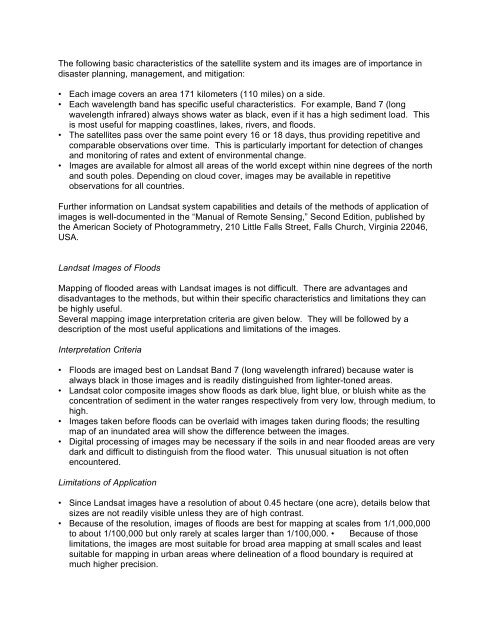Natural Hazards: Causes and Effects - Disaster Management Center ...
Natural Hazards: Causes and Effects - Disaster Management Center ...
Natural Hazards: Causes and Effects - Disaster Management Center ...
Create successful ePaper yourself
Turn your PDF publications into a flip-book with our unique Google optimized e-Paper software.
The following basic characteristics of the satellite system <strong>and</strong> its images are of importance in<br />
disaster planning, management, <strong>and</strong> mitigation:<br />
• Each image covers an area 171 kilometers (110 miles) on a side.<br />
• Each wavelength b<strong>and</strong> has specific useful characteristics. For example, B<strong>and</strong> 7 (long<br />
wavelength infrared) always shows water as black, even if it has a high sediment load. This<br />
is most useful for mapping coastlines, lakes, rivers, <strong>and</strong> floods.<br />
• The satellites pass over the same point every 16 or 18 days, thus providing repetitive <strong>and</strong><br />
comparable observations over time. This is particularly important for detection of changes<br />
<strong>and</strong> monitoring of rates <strong>and</strong> extent of environmental change.<br />
• Images are available for almost all areas of the world except within nine degrees of the north<br />
<strong>and</strong> south poles. Depending on cloud cover, images may be available in repetitive<br />
observations for all countries.<br />
Further information on L<strong>and</strong>sat system capabilities <strong>and</strong> details of the methods of application of<br />
images is well-documented in the “Manual of Remote Sensing,” Second Edition, published by<br />
the American Society of Photogrammetry, 210 Little Falls Street, Falls Church, Virginia 22046,<br />
USA.<br />
L<strong>and</strong>sat Images of Floods<br />
Mapping of flooded areas with L<strong>and</strong>sat images is not difficult. There are advantages <strong>and</strong><br />
disadvantages to the methods, but within their specific characteristics <strong>and</strong> limitations they can<br />
be highly useful.<br />
Several mapping image interpretation criteria are given below. They will be followed by a<br />
description of the most useful applications <strong>and</strong> limitations of the images.<br />
Interpretation Criteria<br />
• Floods are imaged best on L<strong>and</strong>sat B<strong>and</strong> 7 (long wavelength infrared) because water is<br />
always black in those images <strong>and</strong> is readily distinguished from lighter-toned areas.<br />
• L<strong>and</strong>sat color composite images show floods as dark blue, light blue, or bluish white as the<br />
concentration of sediment in the water ranges respectively from very low, through medium, to<br />
high.<br />
• Images taken before floods can be overlaid with images taken during floods; the resulting<br />
map of an inundated area will show the difference between the images.<br />
• Digital processing of images may be necessary if the soils in <strong>and</strong> near flooded areas are very<br />
dark <strong>and</strong> difficult to distinguish from the flood water. This unusual situation is not often<br />
encountered.<br />
Limitations of Application<br />
• Since L<strong>and</strong>sat images have a resolution of about 0.45 hectare (one acre), details below that<br />
sizes are not readily visible unless they are of high contrast.<br />
• Because of the resolution, images of floods are best for mapping at scales from 1/1,000,000<br />
to about 1/100,000 but only rarely at scales larger than 1/100,000. • Because of those<br />
limitations, the images are most suitable for broad area mapping at small scales <strong>and</strong> least<br />
suitable for mapping in urban areas where delineation of a flood boundary is required at<br />
much higher precision.








